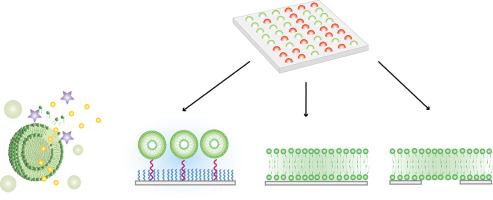Advances in Colloid and Interface Science ( IF 15.6 ) Pub Date : 2017-05-31 , DOI: 10.1016/j.cis.2017.05.020 Federico Mazur , Marta Bally , Brigitte Städler , Rona Chandrawati

|
Biosensors for the rapid, specific, and sensitive detection of analytes play a vital role in healthcare, drug discovery, food safety, and environmental monitoring. Although a number of sensing concepts and devices have been developed, many longstanding challenges to obtain inexpensive, easy-to-use, and reliable sensor platforms remain largely unmet. Nanomaterials offer exciting possibilities for enhancing the assay sensitivity and for lowering the detection limits down to single-molecule resolution. In this review, we present an overview of liposomes and lipid bilayers in biosensing applications. Lipid assemblies in the form of spherical liposomes or two-dimensional planar membranes have been widely used in the design of biosensing assays; in particular, we highlight a number of recent promising developments of biosensors based on liposomes in suspension, liposome arrays, and lipid bilayers arrays. Assay sensitivity and specificity are discussed, advantages and drawbacks are reviewed, and possible further developments are outlined.
中文翻译:

生物传感器中的脂质体和脂质双层
用于对分析物进行快速,特异性和灵敏检测的生物传感器在医疗保健,药物发现,食品安全和环境监测中发挥着至关重要的作用。尽管已经开发了许多传感概念和设备,但是获得廉价,易于使用和可靠的传感器平台的许多长期挑战仍未得到满足。纳米材料提供了令人兴奋的可能性,可提高测定灵敏度并降低检测极限,直至单分子分辨率。在这篇综述中,我们概述了生物传感应用中的脂质体和脂质双层。球形脂质体或二维平面膜形式的脂质组装已被广泛用于生物传感检测的设计中。尤其是,我们重点介绍了悬浮液,脂质体阵列和脂质双层阵列中基于脂质体的生物传感器的最新发展前景。讨论了测定的敏感性和特异性,回顾了优点和缺点,并概述了可能的进一步发展。


























 京公网安备 11010802027423号
京公网安备 11010802027423号